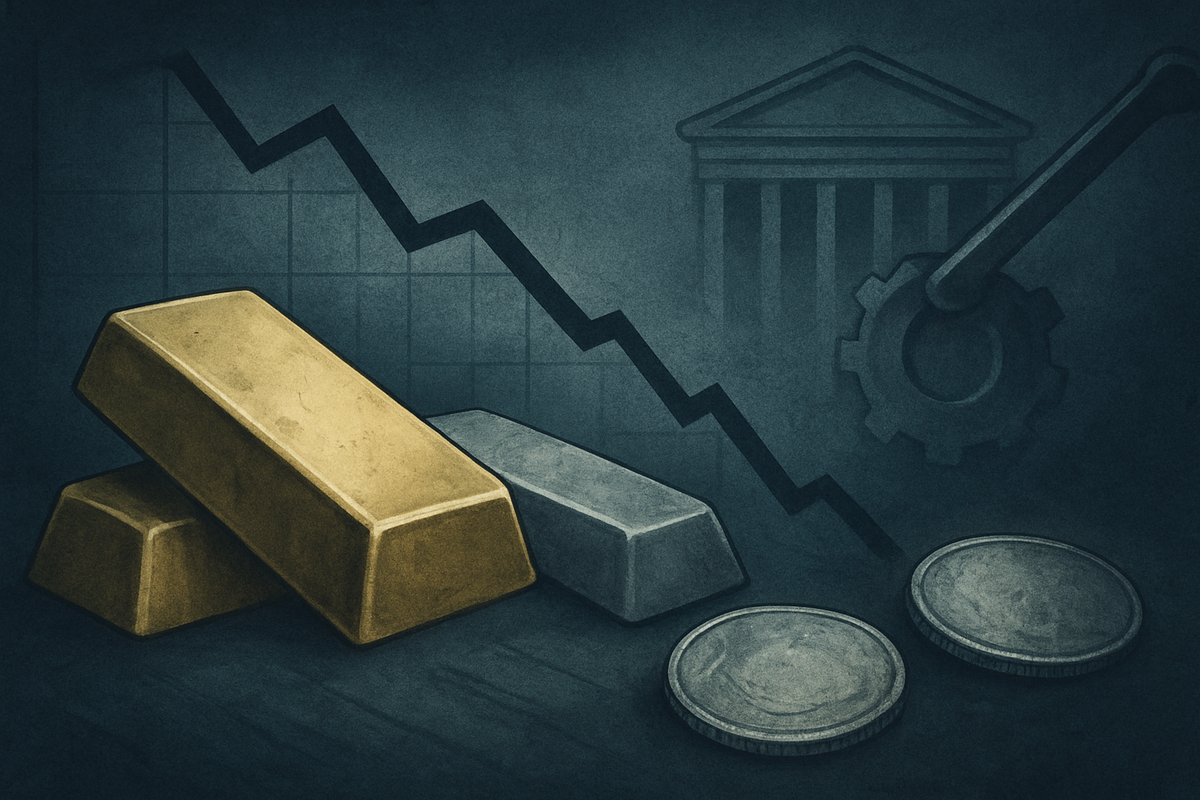
Mumbai, India – November 14, 2025 – The precious metals market has been rocked by a significant downturn, with gold prices plummeting by Rs 5,000 per 10 grams and silver experiencing an even steeper fall of Rs 8,700 per kilogram. This sharp decline is primarily attributed to recent hawkish remarks from U.S. Federal Reserve officials, which have fueled expectations of delayed interest rate cuts and a prolonged period of higher borrowing costs. The immediate implication for investors is a re-evaluation of their portfolios, with many shifting away from non-yielding assets like gold and silver in favor of potentially higher-return investments in a stronger dollar environment.
The sudden depreciation underscores the profound influence of monetary policy on commodity markets, particularly for assets sensitive to interest rate differentials. As the Federal Reserve signals its commitment to combating inflation, the allure of safe-haven assets diminishes, prompting a wave of profit-taking and a reallocation of capital. This market adjustment is creating both challenges for existing holders and potential opportunities for new entrants looking to "buy the dip," especially in a price-sensitive market like India where physical demand often surges on corrections.
Precious Metals Face Headwinds Amidst Fed's Unwavering Stance
The dramatic fall in gold and silver prices unfolded rapidly following a series of statements from key U.S. Federal Reserve officials. Gold, often seen as a hedge against inflation and economic uncertainty, saw its value erode significantly, with a Rs 5,000 per 10-gram drop indicating a substantial percentage decline. Silver, which shares gold's safe-haven characteristics but also has significant industrial demand, experienced an even more pronounced slump of Rs 8,700 per kilogram, highlighting its greater volatility and sensitivity to economic outlooks.
The timeline leading to this moment has been characterized by persistent inflation concerns in the U.S. economy. Despite earlier hopes for a pivot towards rate cuts in early to mid-2025, recent economic data, particularly robust employment figures and sticky core inflation, have emboldened the Federal Reserve to maintain a restrictive monetary policy. Federal Reserve Chair Jerome Powell, alongside other influential governors, has consistently reiterated the central bank's commitment to bringing inflation down to its 2% target, even if it means keeping interest rates elevated for longer than initially anticipated. These "higher for longer" sentiments directly impact precious metals, as a stronger U.S. dollar and rising bond yields increase the opportunity cost of holding non-yielding assets.
Key players involved in this market movement include the U.S. Federal Reserve and its Open Market Committee (FOMC) members, whose public pronouncements are meticulously scrutinized by global markets. Large institutional investors, hedge funds, and commodity traders are also pivotal, as their collective buying and selling decisions amplify price movements. Initial market reactions have seen a clear shift in sentiment, with a strengthening U.S. Dollar Index (DXY) and a rise in U.S. Treasury yields, further pressuring precious metal prices. While some short-term traders are liquidating positions, long-term investors and physical buyers in markets like India are beginning to view the correction as a potential buying opportunity.
Companies Brace for Impact: Winners and Losers in a Shifting Landscape
The significant plunge in gold and silver prices will inevitably create a ripple effect across various public companies, distinguishing potential winners from losers in the financial markets. Mining companies, jewelers, and investment firms with exposure to precious metals are among the most directly impacted stakeholders.
Potential Losers: Gold and silver mining companies are likely to face immediate pressure. Companies like Barrick Gold Corp. (NYSE: GOLD), Newmont Corporation (NYSE: NEM), and Fresnillo PLC (LSE: FRES) will see their revenue and profit margins squeezed as the value of their primary products declines. While their operational costs remain relatively stable, lower selling prices directly translate to reduced profitability. This could lead to a reassessment of expansion projects, potential job cuts, or a slowdown in exploration activities. Companies with higher production costs or significant debt burdens will be particularly vulnerable. Investment funds and ETFs heavily weighted in precious metals, such as the SPDR Gold Shares (NYSE Arca: GLD) or iShares Silver Trust (NYSE Arca: SLV), will see their net asset values decrease, impacting investors holding these instruments.
Potential Winners: Paradoxically, a sharp decline in precious metal prices can create opportunities for certain segments. For instance, jewelers, particularly in consumption-driven markets like India, might experience a surge in demand. Companies like Titan Company Limited (NSE: TITAN) in India, which operates the Tanishq brand, could see increased sales as consumers take advantage of lower prices during auspicious seasons or for weddings. Lower input costs for jewelers could also lead to improved margins on their manufactured goods, provided they can quickly adapt to the new pricing environment and manage inventory effectively. Furthermore, companies that have been waiting to acquire precious metals for industrial use, particularly those involved in electronics, solar panels, and medical devices that utilize silver, might benefit from cheaper raw material costs. Investment firms with a bearish outlook or those adept at short-selling precious metals could also capitalize on the downturn.
The overall impact on these companies will depend on their hedging strategies, operational efficiency, and market positioning. Those with robust balance sheets and diversified portfolios will be better equipped to weather the storm, while others might face significant headwinds, potentially leading to stock price volatility and investor uncertainty.
Broader Implications: A Shift in Market Dynamics and Historical Echoes
The recent plunge in gold and silver prices, driven by hawkish Federal Reserve remarks, extends far beyond the immediate financial impact on companies and investors. It signifies a broader shift in market dynamics, reinforcing the dominance of monetary policy in shaping commodity valuations and investor sentiment. This event fits into a larger trend where the pursuit of inflation control by major central banks globally often comes at the expense of non-yielding assets, especially when real interest rates turn positive or are expected to do so.
The potential ripple effects are substantial. Competitors in the investment landscape, such as bond markets, stand to benefit from the outflow from precious metals. As interest rates rise or are expected to remain high, the attractiveness of fixed-income instruments increases, drawing capital away from commodities. Partners in the supply chain, particularly those providing equipment and services to mining companies, might experience reduced demand for their offerings as miners scale back operations or defer new projects. Regulatory bodies will continue to monitor market stability, but direct policy implications are unlikely unless volatility reaches extreme levels, prompting interventions to ensure orderly markets.
Historically, there are clear precedents for such movements. Periods of aggressive monetary tightening by the Federal Reserve, such as in the early 1980s under Paul Volcker or during certain phases of the 1990s, have often coincided with significant corrections in precious metal prices. These historical comparisons underscore the enduring inverse relationship between real interest rates and the appeal of gold and silver. When the cost of holding cash or investing in interest-bearing assets becomes more attractive, the opportunity cost of holding precious metals, which offer no yield, increases, leading to price depreciation. This current scenario echoes those past periods, reminding investors of the cyclical nature of commodity markets in response to macroeconomic policy shifts.
The Path Ahead: Navigating a New Market Reality
The coming months will be critical for the precious metals market, with short-term and long-term possibilities diverging significantly. In the short term, continued volatility is almost guaranteed as markets digest further economic data releases and Federal Reserve communications. Any signs of persistent inflation or further hawkish surprises could deepen the correction, while unexpected economic weakness or a dovish pivot from the Fed, though currently unlikely, could trigger a swift rebound. Investors should anticipate a period of consolidation, where prices might trade sideways before establishing a clear trend.
Strategically, mining companies may need to pivot towards cost optimization and balance sheet strengthening. Exploration budgets might be trimmed, and focus could shift to high-grade, low-cost operations to maintain profitability. Jewelers, especially in India, will need to closely monitor consumer demand and manage inventory carefully, potentially leveraging lower input costs to offer attractive pricing. For investors, this period presents both challenges and opportunities. Those with a long-term horizon might view the current dip as an opportune entry point, accumulating physical gold or silver, or related ETFs, with the expectation that precious metals will eventually regain their safe-haven appeal amidst future uncertainties.
Potential scenarios range from a prolonged bear market for precious metals if the Fed maintains its hawkish stance well into 2026, to a gradual recovery if inflation recedes faster than expected, allowing for earlier rate cuts. Another scenario involves geopolitical tensions escalating, which could reignite safe-haven demand irrespective of interest rate policies. Market opportunities may emerge for contrarian investors or those with a strong conviction in the long-term value of precious metals as a store of wealth. Conversely, challenges will include managing portfolio risk in a volatile environment and accurately forecasting the Fed's next moves.
A New Chapter for Precious Metals: Summary and Outlook
The recent substantial plunge in gold and silver prices, quantified by drops of Rs 5,000/10 gram and Rs 8,700/kg respectively, marks a significant moment for the precious metals market. The primary drivers are unequivocally the hawkish remarks from U.S. Federal Reserve officials and the accompanying hints of delayed interest rate cuts. This event underscores the paramount influence of monetary policy on non-yielding assets, as higher interest rates increase the opportunity cost of holding gold and silver, simultaneously strengthening the U.S. dollar and reducing the appeal of safe havens.
Moving forward, the market will remain highly sensitive to macroeconomic indicators and the Federal Reserve's communications. Investors should watch for any shifts in inflation trends, employment data, and, most critically, the tone and guidance from FOMC meetings. While the short-term outlook suggests continued pressure and volatility, many experts maintain a long-term bullish perspective on precious metals, citing their role as a hedge against systemic risks and currency debasement, as well as growing industrial demand for silver in emerging technologies.
The lasting impact of this event will likely be a recalibration of investor expectations regarding the timing and pace of interest rate adjustments. It serves as a stark reminder that even traditional safe-haven assets are not immune to the powerful currents of global monetary policy. For investors, the coming months will demand vigilance, strategic patience, and a nuanced understanding of the interplay between central bank actions, economic data, and commodity market dynamics. The current correction, while painful for some, could ultimately lay the groundwork for future opportunities for those prepared to navigate the evolving market landscape.
This content is intended for informational purposes only and is not financial advice






